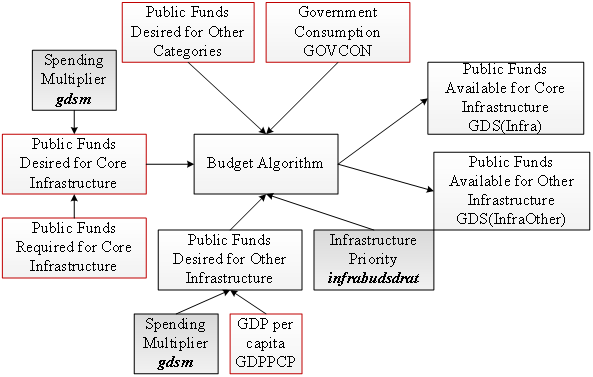International Futures Help System
Determining the Actual Funds for Infrastructure Spending
There is no guarantee that the requirements for infrastructure funds will match those made available. In determining whether this is the case, we focus on the public spending for infrastructure. In IFs, government domestic revenues and net foreign aid are summed into government expenditure (GOVEXP), which is then allocated between transfers, (GOVHHTRN - pensions and other social payments) and direct government spending (GOVCON). The latter is divided among broad categories— defense, education, health, research and development, core infrastructure, other infrastructure, and a residual category of other government spending. It is through this process of allocating government revenues that the amount of public funding for infrastructure ultimately is determined. IFs allows some imbalance between revenues and total expenditures year to year, but neither debt nor surpluses can accumulate indefinitely; as their percentages of GDP change, signals adjust revenues and expenditures over time.
The figure below illustrates how the actual public funds available for core infrastructure are determined starting from the public funds required for core infrastructure estimated in the previous step. During this step, the amount of public funds available for other infrastructure is also determined.

Prior to the budget algorithm, the public funds required for core infrastructure can be modified by a spending multiplier, gdsm(Infrastructure) , to determine the public funds desired for core infrastructure. Similarly, the public funds desired for other infrastructure, which are initially estimated as function of GDP per capita, can be modified by a spending multiplier, gdsm(InfraOther ). Finally, the parameter infrabudsdrat can be used to indicate the priority that should be given to core and other infrastructure in the budget allocation process (it affects both categories equally).
The budget algorithm takes this information, along with the public funds desired for other categories and government consumption to determine the public funds available for core and other infrastructure. First, a fraction, defined by infrabudsdrat divided by 1, of the public funds desired for core and other infrastructure, up to the level of total government consumption, is allocated to these categories and removed from total government consumption (there is a similar parameter, edbudgon , discussed in the Education section of the Help system). The remaining government consumption is allocated to the various categories based upon their desired levels of funding (at this point, the amounts of desired funding for core and other infrastructure does not include the amounts already set aside). In the case of demand-supply mismatches, the subtractions or additions are allocated to each category based on their relative shares of the total desired funding. There is also a minimal level of funds allocated to each category; i.e., each category will receive at least some funds. (Note, the budget allocation process is described in more detail in the governance section of this Help system.)
 International Futures at the Pardee Center
International Futures at the Pardee Center